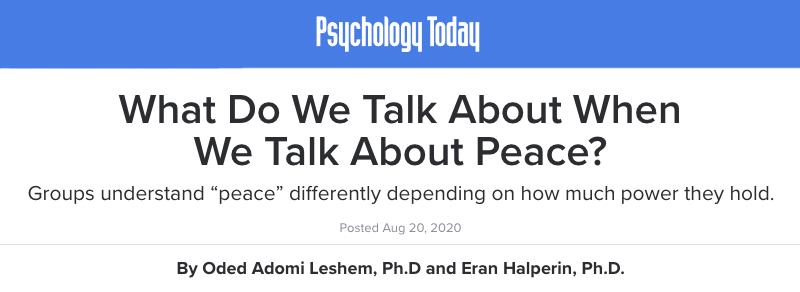Editor’s note: Article co-author Oded Adam Lesham is a postdoctoral fellow at HU’s Psychology of Intergroup Conflict & Reconciliation Lab (PICR) Lab and the Truman Institute for the Advancement of Peace. His research focuses on the nexus of political psychology and conflict resolution with a specialization in violent international and intranational conflicts. A key aspect of his research agenda is to design and test conflict interventions aimed at promoting peace. Co-author Eran Halperin is a full professor of psychology at the Hebrew University of Jerusalem and the Director of HU’s PICR lab. Most of his studies concentrate on the role of emotions and emotion regulation in determining public opinion towards peace and equality, on the one hand, and war and discrimination, on the other.


We often use the word “peace” as if the concept is self-explanatory. When we see the famous peace sign or hear Lennon, Yoko, and millions around the world chanting “give peace a chance,” we seem to think that we all agree what peace is about. People simply assume that the abstract notion of peace, striped from all practical considerations, is obvious.
Of course, everybody also knows that when parties to a conflict negotiate an agreement, they disagree on almost everything, from the way the process should look like to the wording and arrangements of the peace accord. Still, the parties, as well as observers, seem to take it for granted that the idea of peace is universal and self-evident.
A paper we recently published in the Proceedings of the National Academy of Sciences (PNAS) shows that this is not the case at all. In fact, people have very different ideas of what peace “is.” In particular, it appears that during asymmetrical conflicts (i.e., when one side is stronger than the other), members of the advantaged group think of peace in terms of human harmony and friendship, while those from the disadvantaged group understand peace as structural reform.
We saw these trends in data collected as part of the Hope Map Project, a global research project we are conducting in conflict zones around the world. Led by Dr. Leshem, the project compares the hopes for peace of people mired in violent intergroup conflict and explores the antecedents and outcomes of hopes for peace (or, more commonly, the absence of hope). The Hope Map Project contributes to our knowledge of how hope and hopelessness influence political processes on the local, regional, and international levels.
Data for this specific study was collected among 500 Jews residing in Israel and 500 Palestinians living in the West Bank and Gaza Strip. As many readers may know, Jews and Palestinians have been embroiled in a bitter dispute for roughly a century. So far, tens of thousands have perished in the conflict, which still takes a toll on the lives of approximately 14 million people who live between the Jordan River and the Mediterranean Sea. Apart from being protracted and violent, the conflict is also asymmetrical (i.e., one side is stronger than the other), with Israel having superior political, economic, and military power over Palestinians.
Our study shows that for Jewish-Israelis, the concept of peace is related mainly to harmonious relationships between people, but not so much to structural change. This points to the tendency of the advantaged to promote peace by promoting friendly intergroup relations but to do so without giving up their favorable status. Palestinians, on the other hand, associate peace with structural transformation. As the lower-power group, Palestinians’ interpretation of peace is akin to equality, justice, and freedom.

The fact that the two groups use the word “peace” in different ways explains, for example, their common frustration at the conclusion of grassroots peace programs. Although all participants might come highly motivated to advance peace, members of the advantaged group might find it insulting that their desire to establish friendly relationships is met with disapproval from the side of the disadvantaged group. At the same time, those from the disadvantaged group are often infuriated by the fact that participators from the advantaged group fail to see the connection between peace and justice. Lessons could be extrapolated to other asymmetrical intergroup conflicts, including race-based intergroup tensions in the U.S.
Is the picture so bleak? Is there any common ground in the way the adversaries interpret the word “peace”? Our study suggests that the answer is yes. About 70% of respondents from both sides strongly associated peace with what scholars call “negative peace.” Negative peace is defined in terms of what peace is not – violence, war, and bloodshed. Those who tend to interpret peace in this way see peace as the mere absence of war.
One of the most intriguing findings from our study is that the relative weight assigned to each of the three interpretations (harmonious relations, structural reform, and the negation of war) relates to how people think about conflict resolution. In fact, we see that the extent to which the three interpretations overlap, predicts whether people prefer to solve their conflict by either sharing resources or dividing them.
The more people interpret peace as negative peace rather than the harmonious relations or structural change, the more they’re likely to support a solution that entails division of the resources. The more they think of peace as structural change or harmonious relations rather than in negative peace terms, the more they’ll support a peace accord that entails sharing resources. The point being made is that the implicit, perhaps unconscious ways people understand the abstract concept of peace leads them to adopt certain strategies for resolution.
Our study reveals how lay theories about abstract constructs shape our preferences on practical issues concerning our social and political life. This was demonstrated on the concept of peace in the context of the Palestinian-Israeli conflict, but could also hold true for concepts like “justice” and “equality” and the impact of their interpretations on intergroup relations across racial, gender, and socioeconomic divides.